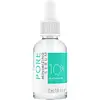What's inside
What's inside
 Key Ingredients
Key Ingredients

 Benefits
Benefits

 Concerns
Concerns

 Ingredients Side-by-side
Ingredients Side-by-side

Water
Skin ConditioningButylene Glycol
HumectantTranexamic Acid
AstringentMandelic Acid
AntimicrobialLactic Acid
BufferingGlycerin
HumectantHydroxyethyl Urea
HumectantGlyceryl Polyacrylate
Caprylic/Capric Triglyceride
MaskingKojic Acid
AntioxidantBeta-Glucan
Skin ConditioningOryza Sativa Bran Extract
Skin ConditioningRhodiola Rosea Extract
EmollientHexylresorcinol
AntimicrobialLecithin
EmollientNiacinamide
SmoothingSalicylic Acid
MaskingPolydextrose
HumectantSodium Acrylates Copolymer
Dextrin
AbsorbentEthylhexylglycerin
Skin ConditioningAmylopectin
Phenoxyethanol
PreservativeWater, Butylene Glycol, Tranexamic Acid, Mandelic Acid, Lactic Acid, Glycerin, Hydroxyethyl Urea, Glyceryl Polyacrylate, Caprylic/Capric Triglyceride, Kojic Acid, Beta-Glucan, Oryza Sativa Bran Extract, Rhodiola Rosea Extract, Hexylresorcinol, Lecithin, Niacinamide, Salicylic Acid, Polydextrose, Sodium Acrylates Copolymer, Dextrin, Ethylhexylglycerin, Amylopectin, Phenoxyethanol
Water
Skin ConditioningNiacinamide
SmoothingGlycerin
HumectantPropylene Glycol
HumectantButylene Glycol
HumectantPanthenol
Skin ConditioningEnantia Chlorantha Bark Extract
Skin ConditioningTocopherol
AntioxidantXanthan Gum
EmulsifyingPentylene Glycol
Skin ConditioningSodium Lauryl Sulfoacetate
CleansingSodium Oleoyl Sarcosinate
Ethylhexylglycerin
Skin ConditioningSodium Chloride
MaskingSodium Oleate
CleansingOleanolic Acid
Skin ConditioningSodium Hydroxide
BufferingPhenoxyethanol
PreservativeParfum
MaskingWater, Niacinamide, Glycerin, Propylene Glycol, Butylene Glycol, Panthenol, Enantia Chlorantha Bark Extract, Tocopherol, Xanthan Gum, Pentylene Glycol, Sodium Lauryl Sulfoacetate, Sodium Oleoyl Sarcosinate, Ethylhexylglycerin, Sodium Chloride, Sodium Oleate, Oleanolic Acid, Sodium Hydroxide, Phenoxyethanol, Parfum
Ingredients Explained
These ingredients are found in both products.
Ingredients higher up in an ingredient list are typically present in a larger amount.
Butylene Glycol (or BG) is used within cosmetic products for a few different reasons:
Overall, Butylene Glycol is a safe and well-rounded ingredient that works well with other ingredients.
Though this ingredient works well with most skin types, some people with sensitive skin may experience a reaction such as allergic rashes, closed comedones, or itchiness.
Learn more about Butylene GlycolEthylhexylglycerin (we can't pronounce this either) is commonly used as a preservative and skin softener. It is derived from glyceryl.
You might see Ethylhexylglycerin often paired with other preservatives such as phenoxyethanol. Ethylhexylglycerin has been found to increase the effectiveness of these other preservatives.
Glycerin is already naturally found in your skin. It helps moisturize and protect your skin.
A study from 2016 found glycerin to be more effective as a humectant than AHAs and hyaluronic acid.
As a humectant, it helps the skin stay hydrated by pulling moisture to your skin. The low molecular weight of glycerin allows it to pull moisture into the deeper layers of your skin.
Hydrated skin improves your skin barrier; Your skin barrier helps protect against irritants and bacteria.
Glycerin has also been found to have antimicrobial and antiviral properties. Due to these properties, glycerin is often used in wound and burn treatments.
In cosmetics, glycerin is usually derived from plants such as soybean or palm. However, it can also be sourced from animals, such as tallow or animal fat.
This ingredient is organic, colorless, odorless, and non-toxic.
Glycerin is the name for this ingredient in American English. British English uses Glycerol/Glycerine.
Learn more about GlycerinNiacinamide is a multitasking form of vitamin B3 that strengthens the skin barrier, reduces pores and dark spots, regulates oil, and improves signs of aging.
And the best part? It's gentle and well-tolerated by most skin types, including sensitive and reactive skin.
You might have heard of "niacin flush", or the reddening of skin that causes itchiness. Niacinamide has not been found to cause this.
In very rare cases, some individuals may not be able to tolerate niacinamide at all or experience an allergic reaction to it.
If you are experiencing flaking, irritation, and dryness with this ingredient, be sure to double check all your products as this ingredient can be found in all categories of skincare.
When incorporating niacinamide into your routine, look out for concentration amounts. Typically, 5% niacinamide provides benefits such as fading dark spots. However, if you have sensitive skin, it is better to begin with a smaller concentration.
When you apply niacinamide to your skin, your body converts it into nicotinamide adenine dinucleotide (NAD). NAD is an essential coenzyme that is already found in your cells as "fuel" and powers countless biological processes.
In your skin, NAD helps repair cell damage, produce new healthy cells, support collagen production, strengthen the skin barrier, and fight environmental stressors (like UV and pollution).
Our natural NAD levels start to decline with age, leading to slower skin repair, visible aging, and a weaker skin barrier. By providing your skin niacinamide, you're recharging your skin's NAD levels. This leads to stronger, healthier, and younger looking skin.
Another name for vitamin B3 is nicotinamide. This vitamin is water-soluble and our bodies don't store it. We obtain Vitamin B3 from either food or skincare. Meat, fish, wheat, yeast, and leafy greens contain vitamin B3.
The type of niacinamide used in skincare is synthetically created.
Learn more about NiacinamidePhenoxyethanol is a preservative that has germicide, antimicrobial, and aromatic properties. Studies show that phenoxyethanol can prevent microbial growth. By itself, it has a scent that is similar to that of a rose.
It's often used in formulations along with Caprylyl Glycol to preserve the shelf life of products.
Water. It's the most common cosmetic ingredient of all. You'll usually see it at the top of ingredient lists, meaning that it makes up the largest part of the product.
So why is it so popular? Water most often acts as a solvent - this means that it helps dissolve other ingredients into the formulation.
You'll also recognize water as that liquid we all need to stay alive. If you see this, drink a glass of water. Stay hydrated!
Learn more about Water